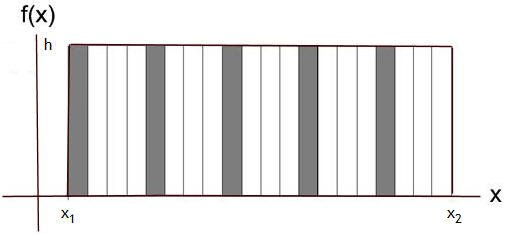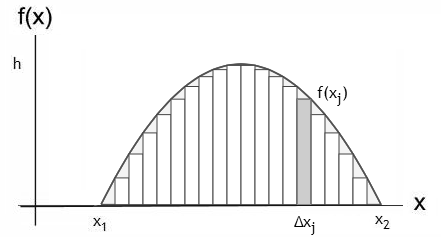Assume that you need to calculate the rate of heat flow through a window. The flow depends on many factors. The window area is one of them. How do you find this area?
For a rectangular widow, you just multiply the widths of the window by the
height of the window.
Let us write this in a slightly awkward form.
Let the x-axis be the horizontal axis and the y-axis the vertical axis.
Let the left corner of the window be at x1 and the right corner at x2.
The width of the window is ∆x = x2 - x1.
Let the height of the window be y = f(x) = h.
The area of the window then is A = f(x)∆x = h(x2 - x1).

Now assume that the window is not rectangular, but has a parabolic shape. The base of the window still extends from x1 to x2. But for the height y we have
y = f(x) = (4h/∆x2)[-x2 + (2x1 + ∆x)x - x1(x1 + ∆x)].
This is the equation of a parabola which crosses the x-axis at x1 and x1 + ∆x and has a height h.

How do we find the area of this window?
Let us find the approximate area by dividing the region between x1
and x2 into N equal intervals ∆xi, i = 1 to N.
If N is large enough and therefore ∆xi is small enough, the area of
the window above the jth interval ∆xj is very close to the area of
the rectangle f(xj)∆xj.
We can then find the area of the widow by summing the areas of all the small rectangles.
A = ∑1N f(xi)∆xi.
The sum is over all i, from 1 to N.

We can do this, for example, using a spreadsheet. The smaller we make ∆xi, the closer our calculated area approaches
the true area of the window.
Letting ∆xi --> 0 ,we convert the sum to a definite integral.
The notation is lim∆xi-->0 ∑x1x2f(xi)∆xi
= ∫x1x2f(x)dx.
Here dx stands for the infinitesimally small interval.
A definite integral represents the area under a curve f(x) from some starting position xi to some ending position xf.
Areas above the x-axis are positive, and areas below the x-axis are negative.

A spreadsheet (or other computer programs) can be used to evaluate a definite integral numerically by converting it into a sum over a large number of very small intervals. Evaluating a definite integral analytically (if possible) is a quicker way of finding the area under a curve.
For many common function f(x) you can look up a formula ∫f(x)dx in a table of
integrals or online.
For example if f(x) = c*xn, with c a constant and n any number not
equal to -1, then
∫f(x)dx = ∫c*xndx = F(x) = c*xn+1/(n+1).
The definite integral ∫x1x2f(x)dx is the found by
evaluating F(x) at the integration limits.
∫x1x2f(x)dx = F(x)|x1x2 = F(x2)
- F(x1).
For example ∫x1x2 c*xndx = c*x2n+1/(n+1)
- c*x1n+1/(n+1).
Finding the area of our window with
f(x) = (4h/∆x2)[-x2 + (2x1 + ∆x)x - x1(x1 + ∆x)],
we integrate f(x) from x1 to x2 = x1 + ∆x.
∫f(x)dx = (4h/∆x2)[-∫x2dx + (2x1 + ∆x)∫x1dx
- x1(x1 + ∆x) ∫x0dx]
=-(4h/∆x2)[-x2/3 + (2x1 + ∆x)x2/2 -
x1(x1 + ∆x) x1/1] = F(x)
∫ x1x2f(x)dx = F(x2) - F(x1).
Note that you can factor out constants to simplify the notation.
Let us simplify and chose x1 = 0, x2 = 1 and h = 1. The ∆x = 1.
Then f(x) = 4[-x2
+ x], ∫f(x)dx = 4[-∫x2dx + ∫xdx] = 4[-x3/3
+ x2/2] = F(x)
F(x2) - F(x1)
= 4[-1/3 + 1/2] = 2/3.
Compare this with the result of the numerical integration using the
spreadsheet.
This semester we will only encounter a few integrals.
The once you may encounter are
Resources:
Definite Integral Calculator
Wolfram online integral calculator